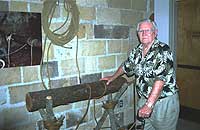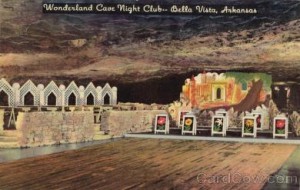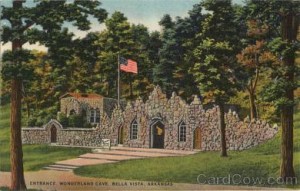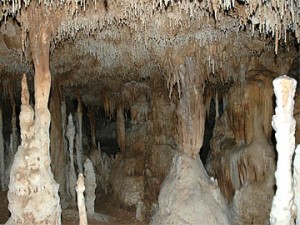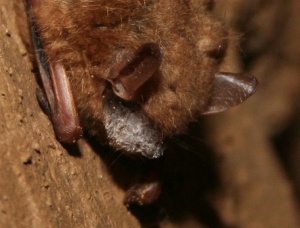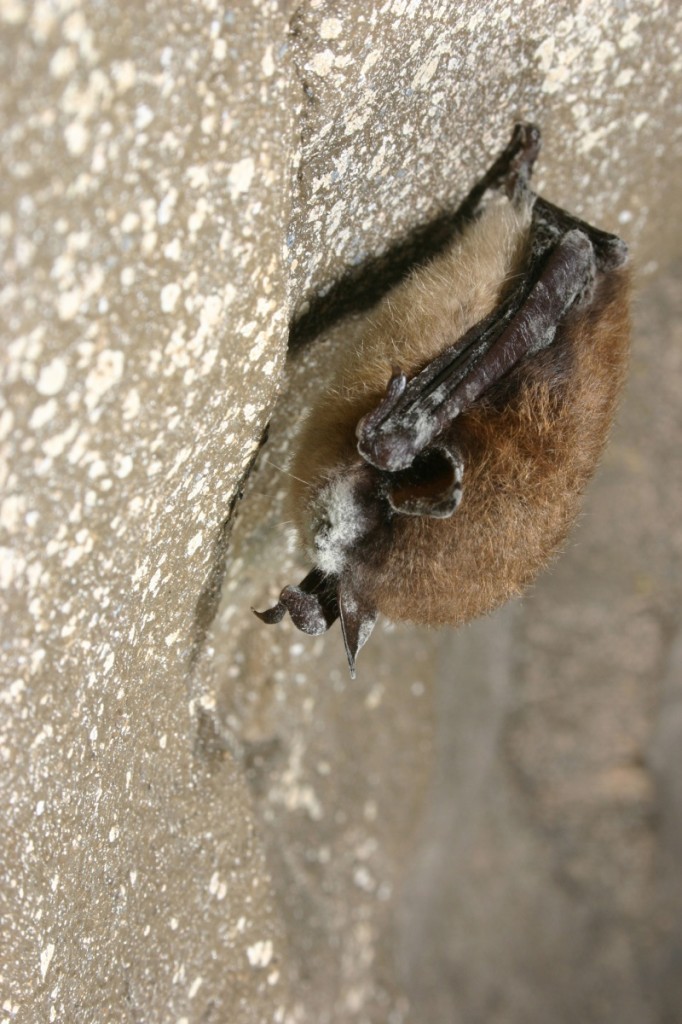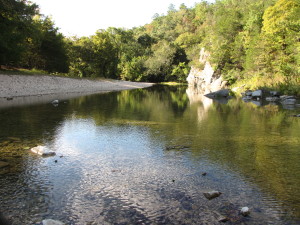 Blanchard Springs Caverns (BSC) is a magnificent limestone cave system starting more than 200 feet underground in the Sylamore Ranger District of the Ozark–St. Francis National Forest, fifteen miles northwest of Mountain View (Stone County). The only cave administered by the U.S. Forest Service, it is considered one of the most beautiful in the country. Three guided tours through the caves are open to the public: the Dripstone Trail (open all year), the Discovery Trail (open during the summer), and the Wild Cave (open by special reservation).
Blanchard Springs Caverns (BSC) is a magnificent limestone cave system starting more than 200 feet underground in the Sylamore Ranger District of the Ozark–St. Francis National Forest, fifteen miles northwest of Mountain View (Stone County). The only cave administered by the U.S. Forest Service, it is considered one of the most beautiful in the country. Three guided tours through the caves are open to the public: the Dripstone Trail (open all year), the Discovery Trail (open during the summer), and the Wild Cave (open by special reservation).
The limestone rock from which the cave developed was formed by fossilized sediment from sea creatures at the bottom of an ancient inland sea estimated to exist about 350–500 million years ago. When prehistoric land masses shifted, the seabed was uplifted about 300 million years ago to form the Ozark Plateau. The exposed land was shaped by the elements, such as wind and rain, into mountains and rivers. When the slightly acidic rainfall penetrated cracks and crevices in the limestone, cavities were formed. Water entered, enlarging the cavities as it flowed through and filled them. As the water cut its way downward, seeking lower levels, it left hollow, air-filled caves. Dripping water from above then deposited calcium carbonate and other minerals to form the cave features and formations, called speleothems, which continue to change as long as water continues to drip.
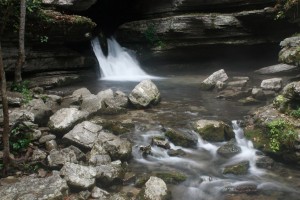 The spring (defined as a natural source of running water) that formed the cavern emerges from the mountainside in a waterfall and flows into a trout pond called Mirror Lake. The spring was named for John H. Blanchard, who left his family’s plantation in Kentucky and fought for the Confederacy, enlisting in the Kentucky Volunteers in 1861. Following bitter conflict at such battles as Chickamauga, where he was wounded, Blanchard sought peace after the war ended by homesteading 160 acres in the tranquil Ozarks. There, he built a gristmill powered by the falling spring which now bears his name. Blanchard was also elected to two terms as Stone County treasurer.
The spring (defined as a natural source of running water) that formed the cavern emerges from the mountainside in a waterfall and flows into a trout pond called Mirror Lake. The spring was named for John H. Blanchard, who left his family’s plantation in Kentucky and fought for the Confederacy, enlisting in the Kentucky Volunteers in 1861. Following bitter conflict at such battles as Chickamauga, where he was wounded, Blanchard sought peace after the war ended by homesteading 160 acres in the tranquil Ozarks. There, he built a gristmill powered by the falling spring which now bears his name. Blanchard was also elected to two terms as Stone County treasurer.
Though there is graffiti in the cave saying “John 1922,” it was not John Blanchard, as he died in 1914 at age seventy-four. Local residents were aware of the cave in the 1930s but the only entrances were a sheer seventy-five-foot drop and underwater through the spring as it exited, so exploration was delayed until more modern technology and equipment could be developed.
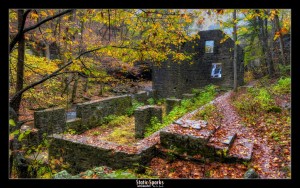 The first documented visit was in 1934, by Civilian Conservation Corps (CCC) planner Willard Hadley. Amateur spelunkers in 1955 found a human cranium, footprints, and other signs of exploration by Native Americans; cane and wooden torch remains underwent radiocarbon dating and indicated that prehistoric human exploration of the cave occurred at least during AD 215–1155. The first professional exploration was in 1960 by Hugh Shell and Hail Bryant. In 1971, scuba divers entered through the spring entrance and followed its course. The divers followed 4,000 feet of underwater passages and also mapped five caverns filled with air but inaccessible at that time. They photographed the awesome cave formations and noted forms of cave life. They estimated that it takes about twenty-four hours for water to flow through the cave, a journey of less than a mile.
The first documented visit was in 1934, by Civilian Conservation Corps (CCC) planner Willard Hadley. Amateur spelunkers in 1955 found a human cranium, footprints, and other signs of exploration by Native Americans; cane and wooden torch remains underwent radiocarbon dating and indicated that prehistoric human exploration of the cave occurred at least during AD 215–1155. The first professional exploration was in 1960 by Hugh Shell and Hail Bryant. In 1971, scuba divers entered through the spring entrance and followed its course. The divers followed 4,000 feet of underwater passages and also mapped five caverns filled with air but inaccessible at that time. They photographed the awesome cave formations and noted forms of cave life. They estimated that it takes about twenty-four hours for water to flow through the cave, a journey of less than a mile.
BSC is referred to as a “living” or “active” cave, as it is constantly being changed. Guides point out that no two tours are the same. The caverns include an underground river, delicate “soda straw” formations, stalactites (pointing downward from the ceiling), stalagmites (rising from the floor), columns (where stalactites and stalagmites meet), and huge areas of flowstone, or sheet-like calcite deposits formed where water flows down a wall or along the floor.
The cave temperature remains at fifty-eight degrees Fahrenheit, making it a popular summertime attraction. The relative humidity hovers around 100 percent, with the trails generally remaining wet. The caverns have been kept as close to natural conditions as possible, though features such as lights, handrails, and paved walkways were added for safety. Guests are advised to bring a jacket and low-heeled, non-slip shoes. From April through October, the caverns are open seven days a week. The rest of the year, they are closed Monday and Tuesday, as well as Thanksgiving, Christmas, and New Year’s Day.
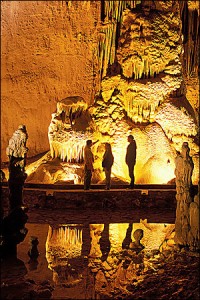 Blanchard Springs Caverns opened to the public in 1973 with the Dripstone Trail Tour after ten years of planning and development. The Dripstone Tour starts by riding an elevator 216 feet below ground and lasts around one hour. Running about a half-mile one way through the most highly decorated area of the caverns, it includes two “rooms” filled with stalactites, soda straws, and a natural bridge, as well as the Cathedral Room, which is more than 1,000 feet long and includes a stone column more than six stories tall. During the Christmas season, the annual Caroling in the Caverns event with vocal and instrumental music takes place in the acoustically superb Cathedral Room; performances sell out each year. The Dripstone Trail tour is recommended for most visitors, especially beginners.
Blanchard Springs Caverns opened to the public in 1973 with the Dripstone Trail Tour after ten years of planning and development. The Dripstone Tour starts by riding an elevator 216 feet below ground and lasts around one hour. Running about a half-mile one way through the most highly decorated area of the caverns, it includes two “rooms” filled with stalactites, soda straws, and a natural bridge, as well as the Cathedral Room, which is more than 1,000 feet long and includes a stone column more than six stories tall. During the Christmas season, the annual Caroling in the Caverns event with vocal and instrumental music takes place in the acoustically superb Cathedral Room; performances sell out each year. The Dripstone Trail tour is recommended for most visitors, especially beginners.
The Discovery Trail tour was opened to the public in 1977. It takes up to two hours, covering just over a mile. There are 686 stair steps in this tour, which is usually recommended for those who do not have health problems or difficulty walking. It descends to the lower level of the cave, 366 feet underground, as well as to the Natural Entrance, about seventy feet below ground at that point, following the streambed of the springs that created the cavern. This tour includes the Rimstone Dams, which create pools along the streambed, and the ethereal Ghost Room with its shimmering white flowstone.
The Wild Cave tour is by reservation only for groups of three to twelve. It provides advanced participants with several hours of climbing, crawling, scaling boulders, wedging under low ceilings, and usually getting dirty as they explore undeveloped parts of the cave. Participants must wear sturdy shoes or hiking boots and are provided with lights, helmets, strong gloves, and kneepads. Participants must be at least ten years old; ten to twelve year olds must tour with a responsible adult.
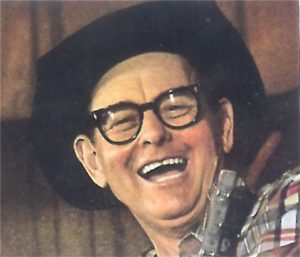 Great care is taken to preserve BSC’s environmental system so that it might be enjoyed in its natural state for generations to come. The Visitor Information Center has a free twenty-minute-movie, The Amazing World Below, and the exhibit hall. Musician Jimmy Driftwood, a Mountain View native, was instrumental in environmental issues and the preservation of Ozark mountain culture. His music is the backdrop of the introductory film on the caverns.
Great care is taken to preserve BSC’s environmental system so that it might be enjoyed in its natural state for generations to come. The Visitor Information Center has a free twenty-minute-movie, The Amazing World Below, and the exhibit hall. Musician Jimmy Driftwood, a Mountain View native, was instrumental in environmental issues and the preservation of Ozark mountain culture. His music is the backdrop of the introductory film on the caverns.
The exhibit hall highlights the plants and animals who call the caverns their home. Shade-loving mosses and ferns can be found near the cave entrance. Farther back in the caverns, only bacteria, mold, and fungi are able to grow. Salamanders, frogs, and crickets are commonly found at BSC. The Discovery Trail attracts the endangered gray bat and is closed when bats are hibernating. Each winter, up to 150,000 bats hibernate undisturbed in this secluded portion of BSC. In the summer, they disperse to other nesting places in and around Arkansas, eating tons of insects, such as mosquitoes.
Some animals spend their entire lives in the darkness of the caves, including the Ozark blind salamander, (the first cave-dwelling amphibian found in America), which is native to Blanchard Springs Caverns. BSC even has its own food chain, with bat droppings (called guano), bacteria, mold, and fungi as sources of food for snails and insects which are in turn eaten by crickets, salamanders, and spiders.
There are nearby campgrounds and seasonal programs with the caverns as centerpiece. Blanchard Springs Caverns was almost recruited by the federal government as a fallout shelter during the Cold War, though the plan was abandoned due to air circulation from the outside spanning only twenty-four hours. Thus, BSC does not sport the familiar black-and-yellow Civil Defense sign as some other caves do. Visitors are usually too dazzled by its awesome beauty to notice.
For additional information:
Blanchard Springs Caverns. https://www.blanchardsprings.org/ (accessed July 18, 2018).
Blanchard Springs Caverns. USDA Forest Service. http://www.fs.usda.gov/detail/osfnf/specialplaces/?cid=stelprdb5351305 (accessed July 18, 2018).
Fleming, John. The Blanchard Springs Caverns Story. N.p.: 1973.
Hill, Carol, and Paolo Forti. Cave Minerals of the World. Huntsville, AL: National Speleological Society, 1977
Nancy Hendricks
Arkansas State University
Related Butler Center Lesson Plans:
N is for Natural State (Grades 3-4); Ozark Folk Culture (Grades 4-8); Places in Arkansas (Grades 4-8)
Last Updated 7/18/2018
